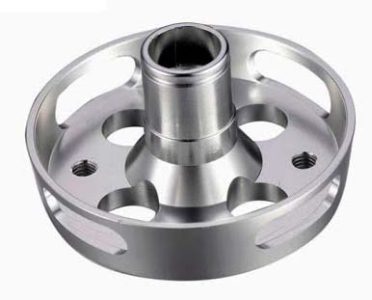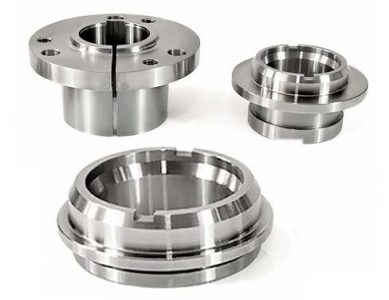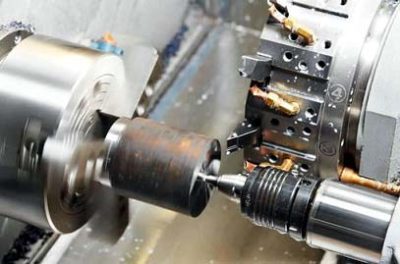Productcategorieën
Productlabels
Technisch voor CNC-draaibankbewerkingsonderdelen
Wat is draaibankverwerking?
Dat is, op de draaibank, de vorm en grootte van de plano worden veranderd door de roterende beweging van het werkstuk en de lineaire of gebogen beweging van het gereedschap, en verwerkt om aan de eisen van de tekeningdelen te voldoen.
Wat is draaibankverwerking?
Dat is, op de draaibank, de vorm en grootte van de plano worden veranderd door de roterende beweging van het werkstuk en de lineaire of gebogen beweging van het gereedschap, en verwerkt om aan de eisen van de tekeningdelen te voldoen.
Turning is a method of cutting the workpiece by using the rotation of the part relative to the tool on the lathe. The cutting function of turning is mainly provided by the workpiece rather than the tool. Turning is the most basic and common cutting method, and it occupies a very important position in production. Turning is suitable for machining revolving surfaces, and most workpieces with revolving surfaces can be processed by turning methods. Such as inner and outer cylindrical surface, inner and outer conical surface, end surface, groove, thread and rotary forming surface, enz., the tools used are mainly turning tools.
Among all kinds of metal cutting machine tools, lathes are the most widely used, accounting for about 50% van het totale aantal werktuigmachines. The lathe can not only use turning tools to turn the workpiece, but also use drills, ruimers, taps and knurling tools for drilling, ruimen, tapping and knurling operations. According to different process characteristics, layout forms and structural characteristics, lathes can be divided into: Horizontal lathes, floor lathes, vertical lathes, turret lathes and profiling lathes, enz., most of which are horizontal lathes.
CNC lathe processing can process various types of materials. There are: 316, 304 roestvrij staal, koolstofstaal, gereedschap staal, gelegeerd staal, legering aluminium, magnesium legering, zink legering, titanium legering, koper, ijzer, plastic, acryl, POM, UHWM en andere grondstoffen. It can process parts with complex structures.
Precautions for CNC lathe processing
De verwerkingstechnologie van een CNC-draaibank is vergelijkbaar met die van een gewone draaibank. Echter, omdat de CNC-draaibank een eenmalige klemming is, continue en automatische verwerking om alle draaiprocessen te voltooien. Daarom, de volgende aspecten verdienen aandacht:
1. Redelijke keuze van de snijhoeveelheid:
For high-efficiency metal cutting processing, the processed material, snijgereedschappen, and cutting conditions are the three major elements. These determine the processing time, tool life and processing quality. The economical and effective machining method must be the reasonable choice of cutting conditions.
Three elements of cutting conditions: Cutting speed, feed rate and depth of cut directly cause tool damage. With the increase of cutting speed, the temperature of the tool tip will rise, which will cause mechanical, chemical and thermal wear. Cutting speed increased by 20%, tool life will be reduced by 1/2. The relationship between the feed condition and the wear on the back of the tool occurs in a very small range. Echter, the feed rate is large, De snijtemperatuur stijgt, and the tool wear is large. It has less influence on the tool than cutting speed. While the impact of the cutting depth of the tool is not as cutting speed and feed large. Echter, when cutting at a small depth of cut, the material being cut produces a hardened layer, which will also affect the life of the tool.
The user should choose the cutting speed to be used according to the processed material, hardheid, cutting state, material type, feed rate, and depth of cut. The most suitable processing conditions are selected on the basis of these factors. Regular, stable wear and longevity are the ideal conditions. Echter, in actual operations, the choice of tool life is related to tool wear, dimensional changes to be processed, oppervlakte kwaliteit, cutting noise, and processing heat. When determining the processing conditions, it is necessary to conduct research according to the actual situation. For difficult-to-machine materials such as stainless steel, heat-resistant alloys, titanium alloys, and magnesium alloys, coolants or turning blades with good rigidity can be used.
2. Choose a tool reasonably:
(1) Bij ruw draaien, choose a tool with high strength and good durability to meet the requirements of large turning depth and large feed when rough turning.
(2) Wanneer u klaar bent met draaien, choose tools with high precision and good durability. To ensure the requirements of machining accuracy.
(3) In order to reduce the time of tool change and facilitate tool setting, machine clamp tools and machine clamp turning blades should be used as much as possible.
3. Reasonable selection of fixtures:
(1) Try to use general fixtures to clamp the workpiece and avoid using special fixtures;
(2) The positioning datums of the parts coincide to reduce positioning errors.
4. Determine the processing route: Het bewerkingstraject is het bewegingstraject en de richting van het gereedschap ten opzichte van het onderdeel tijdens de bewerking van de indexgestuurde werktuigmachine.
(1) It should be able to guarantee the processing accuracy and surface roughness requirements;
(2) Het verwerkingstraject moet zoveel mogelijk worden ingekort om de stilstandtijd van het gereedschap te beperken.

cnc-machine die aluminium draait

machine tool processing machinery parts

turning brass auto parts manufacturing

Clamping for lathe machining
5. The relationship between processing route and machining allowance:
Under the condition that the CNC lathe has not reached the popular use, de overtollige marge op de plano, especially the margin containing the forging and casting hard skin layer, moet op de gewone draaibank worden aangebracht voor verwerking. If you must use a CNC lathe for processing, you need to pay attention to the flexible arrangement of the program.
6. Main points of fixture installation:
The connection between the hydraulic chuck and the hydraulic clamping cylinder is realized by a tie rod. The main points of hydraulic chuck clamping are as follows:
Eerst, remove the nut on the hydraulic cylinder with a moving hand, remove the pull tube, and pull it out from the back of the spindle. Then use the moving hand to remove the chuck fixing screw to remove the chuck.
Neem contact met ons op
Wachten op uw e-mail, wij zullen u binnen antwoorden 12 uur met waardevolle informatie die u nodig had.
 English
English العربية
العربية 中文(漢字)
中文(漢字) Čeština
Čeština Dansk
Dansk Nederlands
Nederlands Suomi
Suomi Français
Français Deutsch
Deutsch Italiano
Italiano 日本語
日本語 ಕನ್ನಡ
ಕನ್ನಡ 한국어
한국어 Português
Português Русский
Русский Slovenčina
Slovenčina Español
Español Svenska
Svenska Türkçe
Türkçe





